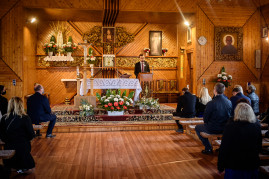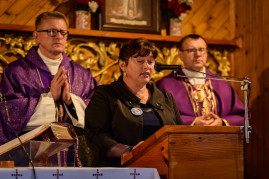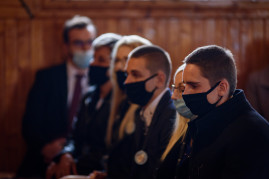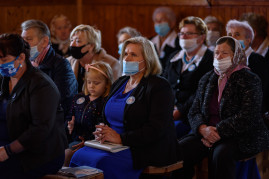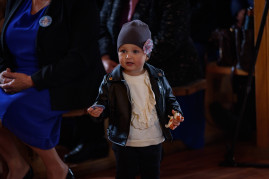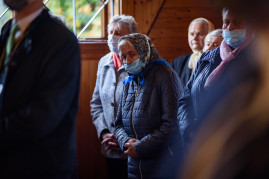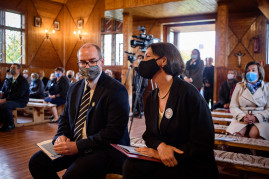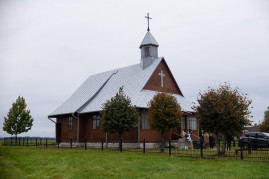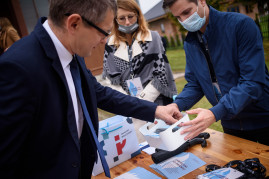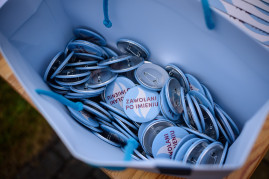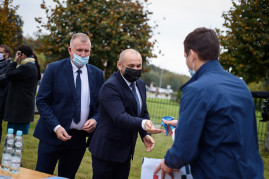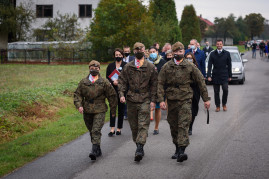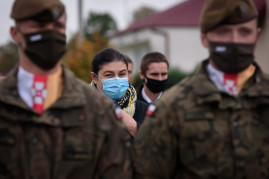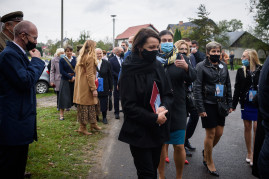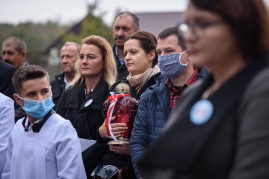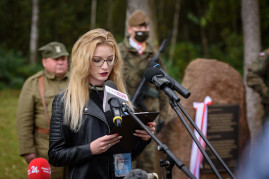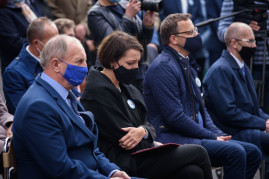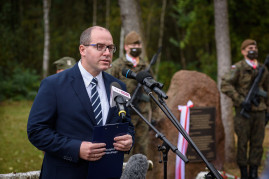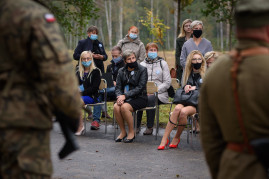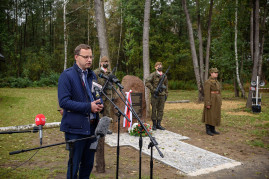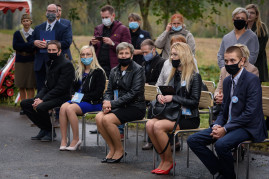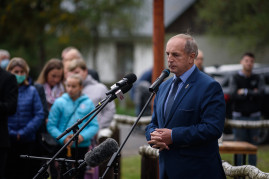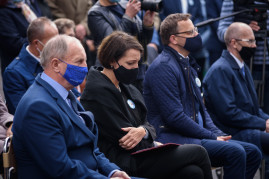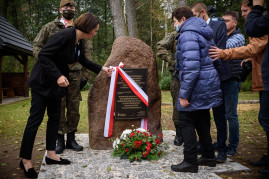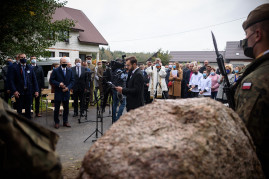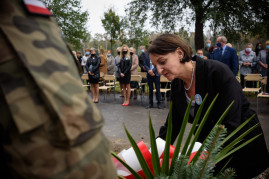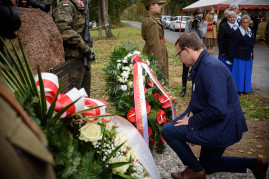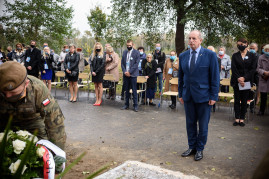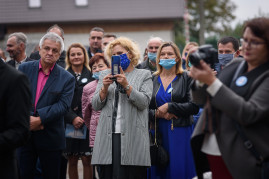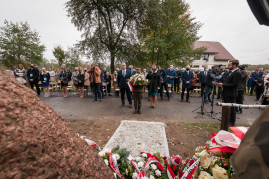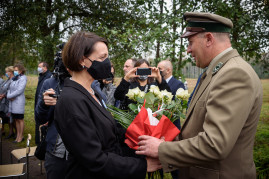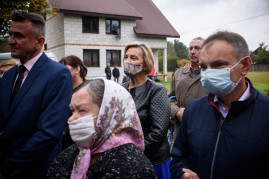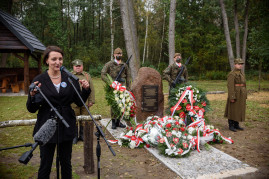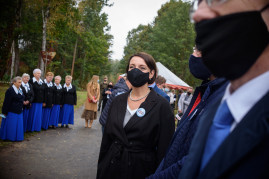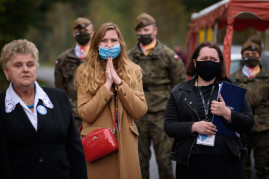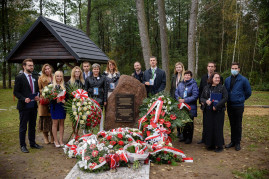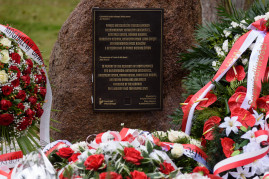Tribute to the residents of Stary Lipowiec - Instytut Pileckiego
Tribute to the residents of Stary Lipowiec
The local residents could perfectly hear the screams coming from the house set ablaze by the Germans. Women and children perished there – six inhabitants of Aleksandrów and Stary Lipowiec and a young Jewish woman. Years later, the Pilecki Institute “called them by name”.
For many years, Józef Kusiak was haunted by a nightmare: a baby screaming, fire, gunshots. As a grown-up man – a father and grandfather – he would cry in his sleep. After waking up, he held long conversations with his wife, who tried to calm him. He went back to sleep with his heart in his mouth, for he never knew when the nightmare would return: the same night, in a week or maybe in a month? He knew the demons of the past would inevitably come back, for these were not simply bad dreams; he was haunted by memories of real-life events.
His trauma was less severe when he was spending time with his loved ones or focused on his work. Paulina Kusiak, his grandson’s wife, spoke thus about his experiences:
To some, Józef could consider himself a lucky man. He survived only because he went to their neighbor with his father Wojciech in order to borrow a kneading trough, as his mother wanted to make sourdough and bake bread for the following day’s Epiphany. Besides, on the wintry day of 5 January 1943, the Kusiaks’ house was already crowded: Katarzyna Rybak had come to grind grain into flour (as an exemplary housewife she wanted to prepare a Biłgoraj buckwheat dumpling for Epiphany), Katarzyna Grochowiak had come to borrow laundry soap, and Janek Zaręba was there to play with Romek, Józef’s brother. They all knew that they could always count on the Kusiak family. Ita Becher, the daughter of a baker from Biłgoraj, also learned that truth when she escaped from the ghetto and found shelter with the Kusiaks. Unfortunately, the young Jewish woman was eventually captured by the Germans. She couldn’t stand their tortures and named all her helpers. The gendarmes killed seven people in Majdan Nowy before the New Year’s Eve, and on 5 January they came with Ita to Stary Lipowiec, to the house of the Kusiak family.
The buildings were visible from the place where Józef, his father, and the relatives of Janek Zaręba were at the time. They saw the Germans. They also saw Janek and Romek loading farm animals onto the carts. Next, they heard gunfire: the boys were shot while trying to escape. Then everything was engulfed in flames. The witnesses could not see what happened next: the gendarmes threw the bodies of the boys into the wooden house, where 6-year-old Franio Kusiak was hiding under the bed, where Katarzyna Rybak sought shelter in the hall, and where Katarzyna Grochowiak covered herself with some straw. All of them were trapped – years later, the neighbors still recalled screams coming from the burning house. Ita Becher and Anastazja Kusiak, Wojciech’s wife, also found death in the flames. All of them were women and children.
Józef Kusiak was haunted by the nightmare for many years, because he saw the Germans murder his mother and two brothers and burn his family house.
After the war, Józef moved to Jarosław and started a family. In the 1990s he erected a symbolic tombstone at the site of the tragedy. He wanted it to be a place where his children and grandchildren – and maybe some residents of the village – would come to pray. He would have never thought that his grandchildren and great-grandchildren would witness the Polish state reinstate the memory about the murdered.
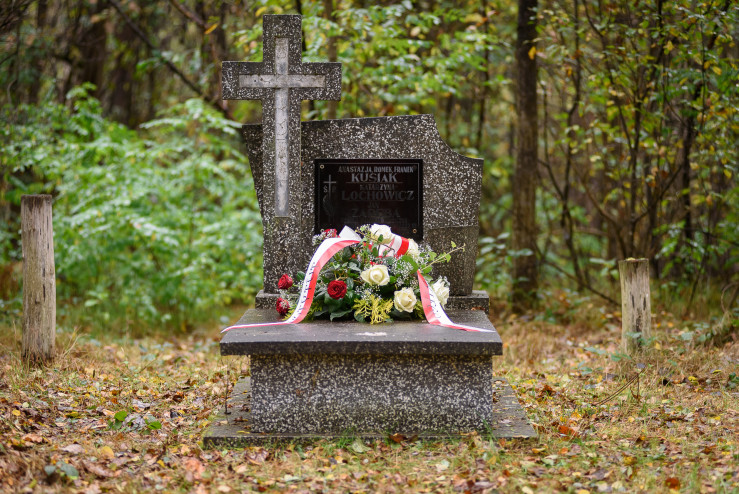
And that is what happened on 8 October 2020 in Stary Lipowiec. On that day, as part of the “Called by Name” project, the Pilecki Institute commemorated Katarzyna Grochowicz, Anastazja Kusiak, Roman Kusiak, Franciszek Kusiak, Katarzyna Rybak and Jan Zaręba, who gave their lives for another. Among the participants in the event were the descendants of the victims and the local community, as well as Prof. Magdalena Gawin, the Deputy Minister of Culture and National Heritage and initiator of the “Called by Name” project; Dr. Wojciech Kozłowski, director of the Pilecki Institute; and Jarosław Piskorski, head of the Księżopol commune. The commemoration began with a mass celebrated in the Chapel of Saint Jadwiga of Poland by Rev. Adam Sobczak.
Before the unveiling of a commemorative plaque devoted to the residents of Stary Lipowiec, Prof. Magdalena Gawin made reference to the liturgy and stressed that Christians are obligated to forgive, but they should never forget the past tragedy: “This story has to transcend the borders of the local community. The entire Poland must learn of these events […]. Their names are carved in stone so that they can survive for ages, so that the memory of these horrible events can never be erased and so that the young generation can know where they live and what price had to be paid by the local people for helping others. We must never forget. We are gathered here today to say that we remember. And that we always will.”
Dr. Wojciech Kozłowski also emphasized the role of collective memory: “The ‘Called by Name’ project is based on two foundations: the family, as it was the family who bore the heavy burden of the tragedy that befell them during the German occupation, and the place where it happened. This is why we meet with the family, and this is why we meet here.” The Director of the Pilecki Institute added that there is no greater sacrifice than to give your life for another: “Today we want to honor all the murdered persons, but first of all we want to paint a broader picture, to show that the world created by the German occupant was a world where good deeds were punished. The fact that they found courage to show a human face, to maintain their humanity in a world where such attitudes were punished, is of the utmost value, and for that we – all of us gathered here, but also all Poles – want to thank them.”
The ceremony in Stary Lipowiec was the 15th commemoration as part of the “Called by Name” project that was inaugurated on 24 March 2019. You can read more about the project here.
